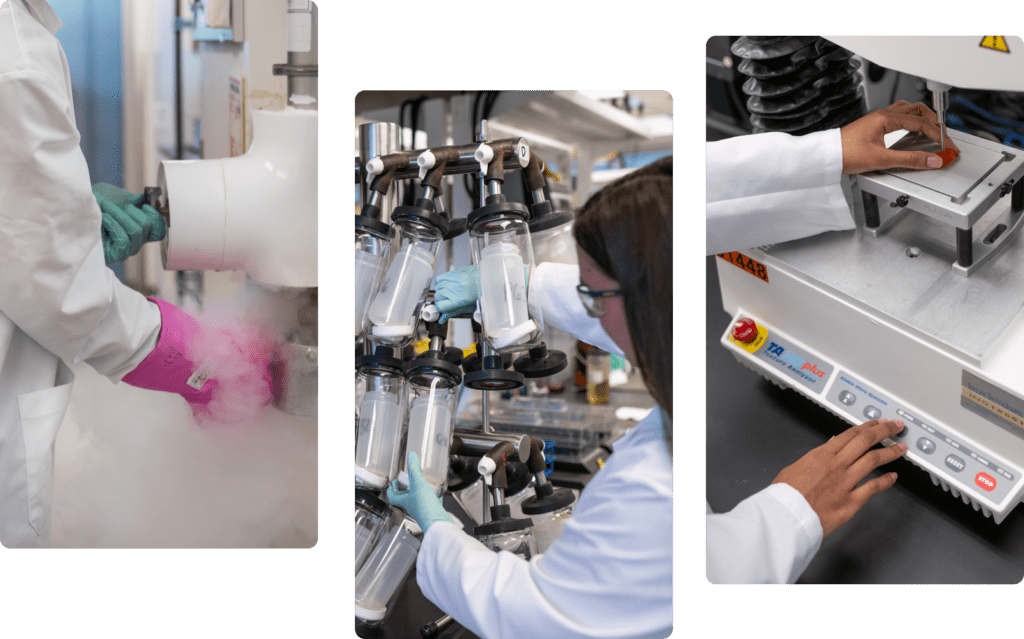Peroxidase Activity Test
- Price
$285 per analysis
- Turnaround time
7 – 9 Business Days
- Rush
Available

Technical data sheet
- Method description
Samples are homogenized and enzymes are extracted into a cold, pH 6.5 buffer. A protein determination by the Bradford method is performed on the enzyme extract (supernatant) to normalize subsequent enzyme results to the efficiency of the protein extraction. The enzyme extract is mixed with hydrogen peroxide, guaiacol, and calcium. Peroxidase activity is measured spectrophotometrically by the rate of formation of tetraguaiacol at 470nm.
- Acceptable matrices
Grains, flours, and vegetables.
- Limit of quantitation
1.06 U/gram
- Equipment
UV/Vis spectrophotometer, homogenizer, microplate reader
- Method reference
Britton Chance, A.C. Maehly, Method in Enzymology, Assay of catalases and peroxidases. Vol 2, Academic Press, New York, 1955, pp. 764-775.
- Reportable unit
1 Unit = 0.5 µM of Guaiacol consumed per minute under assay conditions.
- Sample size requirements
10 g
- Information required by submitter
Please supply estimates
- Additional information
Peroxidase is an enzyme that can catalyze the cross-linking of phenolic residues by H2O2 resulting in undesirable color changes (graying) and the potential generation of off-flavors in a food product. Determining the average level of peroxidase in different cultivars can help guide breeding decisions. Additionally, because peroxidases are relatively stable enzymes, they can serve as an indicator for the efficacy of enzyme inactivating treatments in grains and flours (heat treatment, chemical treatment, etc.) Please keep and ship samples frozen, if possible.
Common Peroxidase Activity Test Testing Questions
Peroxidases are enzymes capable of reducing hydrogen peroxide and other hydroperoxides to water. Peroxidase activity measures an enzymes capacity to perform this reduction.
Peroxidase Activity is reported as U/g
Specific Activity is reported as U/mg (of protein)
Bradford Extractable Protein is reported as mg/g
Enzyme Activity measures the amount of substrates converted to products by the enzyme in moles per unit of time (In general, Â the efficiency of an enzyme)
Specific Activity is equivalent to the activity of an enzyme per mg of total protein (In general, the purity of an enzyme)
Extractable Protein is the amount of protein measured by the Bradford protein assay (the result is used to determine the specific activity)
Peroxidase is an enzyme present in raw plant foods that can catalyze the cross-linking of phenolic residues by H2O2 resulting in undesirable color change (graying) and the potential generation of off-flavors in the food product. Additionally, because peroxidases are relatively stable enzymes, they can serve as an indicator for the efficacy of enzyme inactivating treatments in grains and flours (e.g. heat treatment, chemical treatment, etc.)
Peroxidase is an enzyme found in a wide variety of organisms, from plants to humans to bacteria. Its function is to break down hydrogen peroxide (H2O2), which is one of the toxins produced as a byproduct of using oxygen for respiration and is an indicator of the rate of spoilage in food products.
We make every effort to keep our methods and detection limits up to date according to the latest standards and qualifications. If you have any questions regarding the limit of detection/quantification or method references, please contact our Customer Service team at 1-800-245-5615.
Our standard turnaround time is 10 business days for most assays. There are some assays that require a longer turnaround time. We also offer a RUSH service that is half the time of the standard turnaround time of the assay at double the cost of the assay. A few assays that we provide cannot be rushed due to the nature of the test. Please check the specific assay you are interested in regarding the ability to RUSH the turnaround time.
Our food testing experts are here to help.
"*" indicates required fields

Helpful content related to Peroxidase Activity Test
Submit your order online and ship your samples today. If you have questions, we are always here to help.
A food testing program designed with mid-market and enterprise food and ingredient manufacturers in mind.
